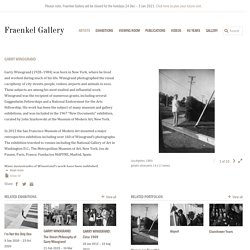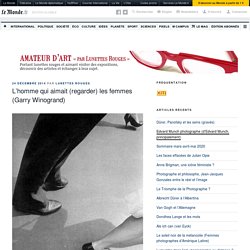

(65) Garry Winogrand - Photographer. Fraenkel Gallery. Garry Winogrand (1928–1984) was born in New York, where he lived and worked during much of his life.

Winogrand photographed the visual cacophony of city streets, people, rodeos, airports and animals in zoos. These subjects are among his most exalted and influential work. Winogrand was the recipient of numerous grants, including several Guggenheim Fellowships and a National Endowment for the Arts Fellowship. His work has been the subject of many museum and gallery exhibitions, and was included in the 1967 “New Documents” exhibition, curated by John Szarkowski at the Museum of Modern Art, New York. Garry Winogrand vidéo Jeu de Paume. (57) Garry Winogrand - Part 1. Garry Winogrand - Part 2. ClassTimewithGarryWinograndfinal3. 10 Things Garry Winogrand Can Teach You About Street Photography - ERIC KIM. (Above image: Garry Winogrand, World’s Fair, New York City, 1964.

All photographs in this article copyrighted by the estate of Garry Winogrand) Garry Winogrand is one of my favorite street photographers that I have gained much photographic insight and wisdom from. He was in-arguably one of the most prolific street photographers of his time (he shot over 5 million photographs in his career) and one of the most passionate. However, he hated the term “street photographer” and simply saw himself as a “photographer”.
It is an idea I later understood and respected very dearly, as Winogrand was more interested in making photographs than classifying himself for art historians. I never understood a lot of the things that he said about photography like why you should wait a year or two before developing your shots, why photographs don’t tell stories, and how photographers mistake emotion for what makes great photographs. 1. Garry Winogrand shot a lot of photographs. “When in doubt, click” 2. 3. 4. 5 Garry Winogrand Street Photography Composition Lessons. Dear friends, I want to analyze some compositions I really like from Garry Winogrand; and share how we can better incorporate more edgy compositions into our own work: Download ZIP with JPEG IMAGES > 1.

Boy alone on the far left, evenly spaced boys on the far right, leaning over to him: This is seriously one of the most epic composition photos I’ve seen: Note the out of focus dogs in the foreground (pink): Abstracted, to see all the shapes and forms: 2. Simple depth photo: 3. All the elements pointing or looking at different directions; adding a lot of dynamic pulling in the frame in different directions! 4. Very simple yet effective: put something in the foreground (like the hood of a car) and fill the frame with it– to block out the distractions, to focus on the other stuff in the frame (like the man in cyan): Garry Winogrand - The First "Digital Photographer" Shooting Film — about photography blog. In the 50s and 60s He worked as a freelance advertising photographer and photojournalist but later on rejected magazines and move solely to the world of art.

The First mention about his published work is from 1955 when he had two of his photographs at The Family of Man exhibition at the Museum of Modern art in NY, which was a big exhibition bringing together hundreds of images from all over the world. In the form of a photo essay the exhibition celebrated universal aspects of the human experience. His first solo exhibition was held at the Image Gallery in New York in 1959. He was also awarded several Guggenheim Fellowships which are grants awarded to those who have demonstrated exceptional capacity for productive scholarship or exceptional creative ability in the arts. He was shooting mostly with his Leica M4 35, and later 28mm lens that allowed him to capture a big portion of the street.
“Well what is a photograph? “The world isn't tidy; it's a mess. Garry Winogrand. Garry Winogrand was born in New York City and became interested in photography while serving in the military as a weather forecaster.

He studied painting at City College (1947-48) and at Columbia University (1948-51), where he learned how to develop and print. In 1951 he studied photography with Alexey Brodovitch at the New School for Social Research. Afterward he worked commercially for photography agencies, freelanced for magazines, and also did personal work. Winogrand's photographs were exhibited widely during his lifetime, in Edward Steichen's The Family of Man at the Museum of Modern Art, Towards a Social Landscape at the George Eastman House, and New Documents at the Museum of Modern Art.
He was often grouped with photographers such as Danny Lyon or Lee Friedlander as a documentarian of the "social landscape. " Garry Winogrand. Voir le portrait filmé de l'exposition : Le Jeu de Paume présente la première rétrospective, depuis vingt-cinq ans, du grand photographe américain Garry Winogrand (1928-1984).

Chroniqueur célèbre de l’Amérique de l’après-guerre, Winogrand est encore mal connu, tant il a laissé de travail à accomplir — au moment de sa mort prématurée — dans l’archivage, le développement et le tirage de ses photographies. Il est cependant sans conteste l’un des maîtres de la photographie de rue américaine, au même titre qu’Evans, Frank, Friedlander ou Klein. Cours sur la photo numérique. Photographe américain né en 1928 New York City et mort en 1984 au Mexique.

Il appartient à la famille des "street photographers", déambulant en rue, l’appareil toujours chargé et en main. Il donne au genre quelques images fameuses, d’une netteté implacable, aux contrastes forts, exercices sans cesse renouvelés de faire image avec l’accident constant de la foule et de la rencontre. L’homme qui aimait (regarder) les femmes (Garry Winogrand) – Amateur d'art. En espagnol Je laisse à d’autres le soin de débattre à propos des tirages posthumes de Garry Winogrand au Jeu de Paume (jusqu’au 8 février) : quand un photographe néglige de tirer ses photographies, voire même de développer ses pellicules, remettant cela à plus tard, et qu’une mort soudaine le ravit, avons-nous ou non le droit de montrer ces photographies orphelines ?

C’est le cas d’environ 40% des photographies montrées ici, des « images demandant à être vues ». Beau débat éthico-artistique, certes, mais que je ne vais pas aborder ici : qu’est-ce que l’œuvre ? Je note simplement que, dans l’exposition, dans le catalogue (excellent !) Cette exposition a une grande ambition, mais le visiteur (moi en tout cas) va à son encontre.
Thème essentiel certes, mais pas thème unique. Toutes ses photos de femmes ou presque sont tragiques. . « Toutes les fois que j’ai vu une jolie femme, j’ai tout fait pour la photographier. Garry Winogrand. Garry Winogrand - The First "Digital Photographer" Shooting Film. Garry Winogrand at Rice University.